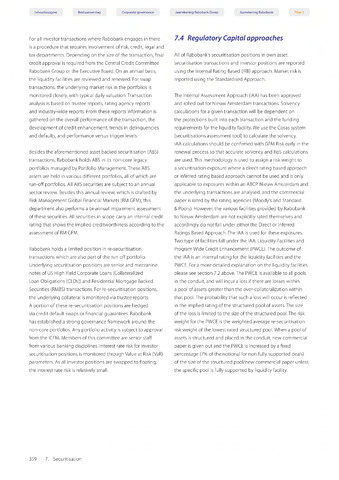7.4 Regulatory Capital approaches
Inhoudsopgave Bestuursverslag Corporate governance
For all investor transactions where Rabobank engages in there
is a procedure that requires involvement of risk, credit, legal and
tax departments. Depending on the size of the transaction, final
credit approval is required from the Central Credit Committee
Rabobank Group or the Executive Board. On an annual basis,
the liquidity facilities are reviewed and renewed. For swap
transactions, the underlying market risk in the portfolios is
monitored closely, with typical daily valuation.Transaction
analysis is based on trustee reports, rating agency reports
and industry-wide reports. From these reports information is
gathered on the overall performance of the transaction, the
development of credit enhancement, trends in delinquencies
and defaults, and performance versus trigger levels.
Besides the aforementioned asset backed securitisation (ABS)
transactions, Rabobank holds ABS in its non-core legacy
portfolios managed by Portfolio Management. These ABS
assets are held in various different portfolios, all of which are
run-off portfolios. All ABS securities are subject to an annual
sector review. Besides this annual review, which is drafted by
Risk Management Global Financial Markets (RM GFM), this
department also performs a bi-annual impairment assessment
of these securities. All securities in scope carry an internal credit
rating that shows the implied creditworthiness according to the
assessment of RM GFM.
Rabobank holds a limited position in re-securitisation
transactions which are also part of the run-off portfolio.
Underlying securitisation positions are senior and mezzanine
notes of US High Yield Corporate Foans (Collateralized
Loan Obligations (CLOs)) and Residential Mortgage Backed
Securities (RMBS) transactions. For re-securitisation positions,
the underlying collateral is monitored via trustee reports.
A portion of these re-securitisation positions are hedged
via credit default swaps or financial guarantees. Rabobank
has established a strong governance framework around the
non-core portfolios. Any portfolio activity is subject to approval
from the ICFM. Members of this committee are senior staff
from various banking disciplines. Interest rate risk for investor
securitisation positions is monitored through Value at Risk (VaR)
parameters. As all investor positions are swapped to floating,
the interest rate risk is relatively small.
Jaarrekening Rabobank Groep Jaarrekening Rabobank
All of Rabobank's securitisation positions in own asset
securitisation transactions and investor positions are reported
using the Internal Rating Based (IRB) approach. Market risk is
reported using the Standardised Approach.
The Internal Assessment Approach (IAA) has been approved
and rolled out for Nieuw Amsterdam transactions. Solvency
calculations for a given transaction will be dependent on
the protections built into each transaction and the funding
requirements for the liquidity facility. We use the Cosas system
(securitisations assessment tool) to calculate the solvency.
IAA calculations should be confirmed with GFM Risk early in the
renewal process so that accurate solvency and RoS calculations
are used. This methodology is used to assign a risk weight to
a securitisation exposure where a direct rating based approach
or inferred rating based approach cannot be used and is only
applicable to exposures within an ABCP. Nieuw Amsterdam and
the underlying transactions are analysed, and the commercial
paper is rated by the rating agencies (Moody's and Standard
Poors). However, the various facilities provided by Rabobank
to Nieuw Amsterdam are not explicitly rated themselves and
accordingly do not fall under either the Direct or Inferred
Ratings Based Approach. The IAA is used for these exposures.
Two type of facilities fall under the IAA: Liquidity Facilities and
Program Wide Credit Enhancement (PWCE). The outcome of
the IAA is an internal rating for the liquidity facilities and the
PWCE. For a more detailed explanation on the liquidity facilities
please see section 7.2 above. The PWCE is available to all pools
in the conduit, and will incur a loss if there are losses within
a pool of assets greater than the over-collateralization within
that pool. The probability that such a loss will occur is reflected
in the implied rating ofthe structured pool of assets. The size
of the loss is limited to the size ofthe structured pool.The risk
weight for the PWCE is the weighted average re-securitisation
risk weight ofthe lowest rated structured pool. When a pool of
assets is structured and placed in the conduit, new commercial
paper is given out and the PWCE is increased by a fixed
percentage (7% ofthe notional for non-fully supported deals)
ofthe size ofthe structured pool/new commercial paper unless
the specific pool is fully supported by liquidity facility.
359 7. Securitisation

